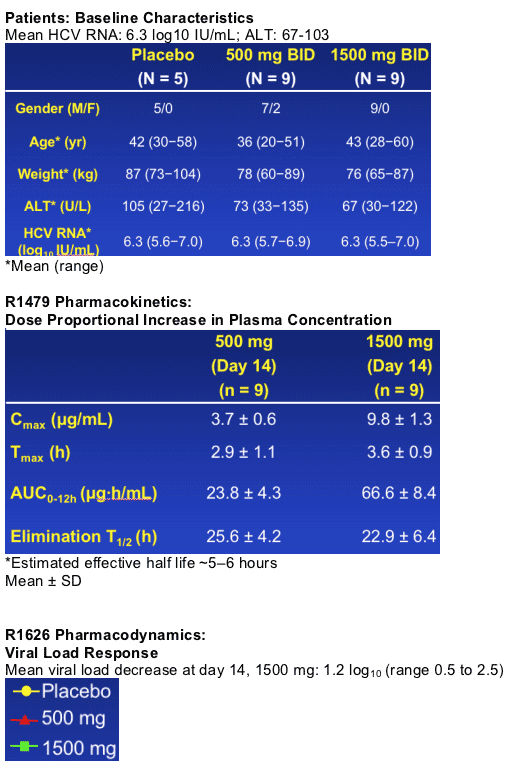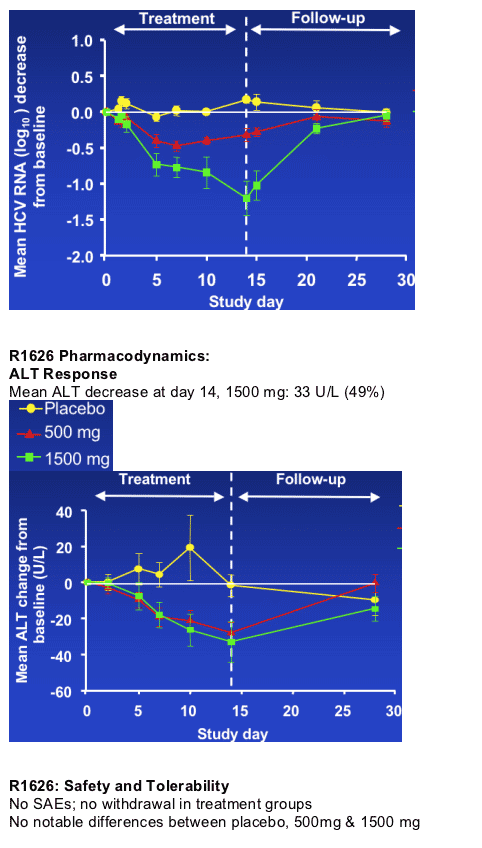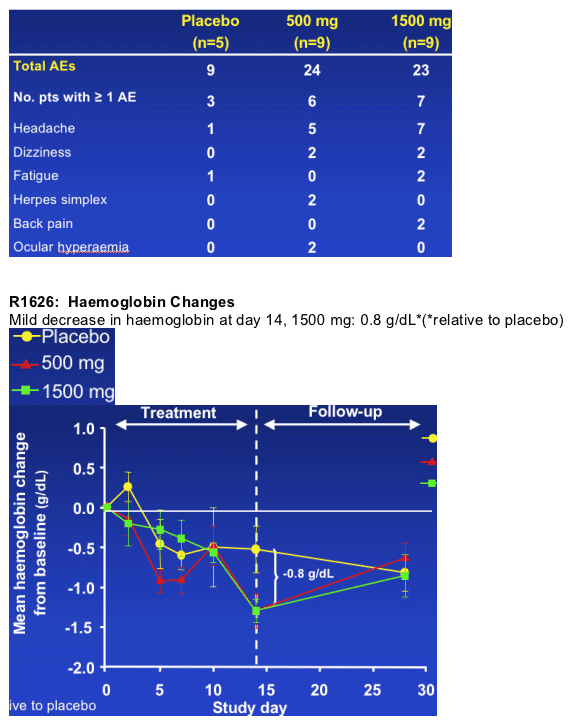 |
 |
 |
| |
Interim results of a multiple ascending dose study of R1626, a novel nucleoside analogue targeting HCV polymerase, in chronic HCV patients
|
| |
| |
Reported by Jules Levin
EASL conference
April 29, 2006, Vienna, Austria
Stuart Roberts (The Alfred Hospital & Centre for Clinical Studies, Melbourne, Australia) reported these study results. One of the big stories here at EASL is whether or not Vertex or Schering will use ritonavir to boost their HCV PI. Abbott reported intriguing data here showing in rat & human microsomes that ritonavir can significantly boost the drug levels for both HCV protease inhibitors VX-950 & SCH 503034, as it does for HIV protease inhibitors. But it remains to be seen whether Vertex & Schering will utilize this boosting approach. Boosting with ritonavir can make the HCV PI regimens more convenient by reducing the dose of the HCV PI and reducing the daily dosing regimens as both HCV PIs are dosed now 3 times per day.
AUTHOR SUMMARY
R1626 was safe and well tolerated at 500 mg and 1500 mg BID doses
Dose proportional increases in plasma concentrations were observed following
500 mg and 1500 mg BID
Mean viral load reductions of 1.2 log10 were observed by Day 14 following 1500 mg BID
Treatment-related reductions in ALT were observed following 500 mg and 1500 mg (mean 33 U/mL)
AUTHOR CONCLUSION & FUTURE DIRECTIONS
R1626, a novel nucleoside analogue HCV polymerase inhibitor, is well tolerated and shows promising antiviral activity.
Additional high dose groups are ongoing.
Phase II combination therapy clinical trial planned to start in Q3 2006.
BACKGROUND
Pegylated interferon-a2a (40KD) + ribavirin is currently the standard of care for most patients with chronic hepatitis C
Clinical utility of this therapy is limited in difficult to treat patients by:
- Sub-optimal sustained viral response (SVR)
- High incidence of side effects
There is a high unmet medical need for safe and effective antiviral agents to treat chronic hepatitis C.
HCV polymerase

- NS5B gene product
- RNA-dependent RNA polymerase
- Essential enzyme for hepatitis C viral replication
R1626: Characteristics
- Pro-drug of the nucleoside analogue, R1479, a potent and selective inhibitor of the HCV polymerase enzyme
- Testing of the parent compound (R1479) in healthy volunteers and HCV patients revealed no significant safety issues
- R1626 was developed to significantly increase bioavailability and HCV inhibition
Study Objectives
Multiple ascending dose study in chronic HCV patients is currently ongoing
To evaluate:
- Safety/tolerability
- Pharmacokinetics (PK)
- Anti-viral activity of multiple doses of R1626
First two dose groups presented
Study Design
Multi-centre, observer-blinded, randomised, placebo-controlled, multiple ascending-dose study.
Two dose levels twice daily (BID) for 14 days
- 500 mg (9 active and 2 placebo)
- 1500 mg (9 active and 3 placebo)
Major Inclusion Criteria
- Treatment na´ve patients with chronic HCV genotype 1 infection
- Males and females (non-childbearing potential)
- Age: 18 to 60 years
- Metavir fibrosis stage L 2
- Serum HCV RNA of ≥ 105 IU/mL (100,000)
- ALT L 5 times of ULN
Methods
Pharmacokinetics
- Determined on Days 1, 7 and 14
Pharmacodynamics (viral load and ALT)
- Screening, pre-dose (Days -14 , -1 and 1) and post-dose (Days 2, 5, 7, 10, 14, 15, 21 and 28)
Safety
- Laboratory chemistry and haematology
- Adverse events (AEs)
- Time matched ECGs
- Vital signs



|
| |
|
 |
 |
|
|